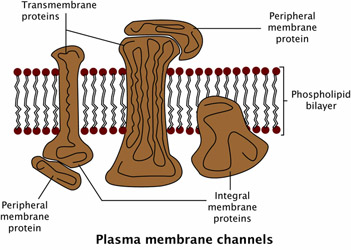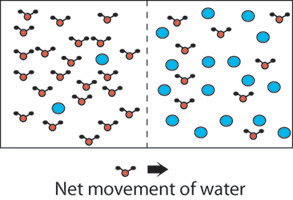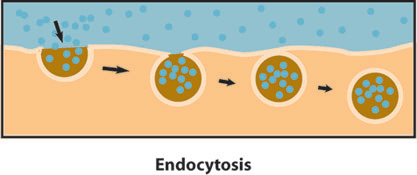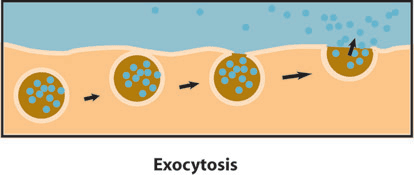 username@email.com
username@email.com
The plasma membrane encloses and protects the contents of the cell. As with all living things, however, cells do interact with their environment. This means that material must be able to pass into the cell and out of the cell through the plasma membrane. The thin and seemingly simple, plasma membrane is actually a complex structure that serves as an effective barrier that keeps unwanted material out of the cell, while permitting the entry of useful substances. This makes the plasma membrane selectively permeable — only allowing in needed substances and keeping out unwanted material.
The plasma membrane selectively allows transport of substances into and out of the cell. Intrinsic proteins on the membrane enable passage of large, water-soluble molecules and ions across the plasma membrane and into the cell. Some of these proteins produce channels, like tiny pores, through which molecules can pass. Some channels are akin to gatekeepers that open only when a particular chemical signals its “intent” to enter the cell. Gap junctions are protein channels that permit communication between cells.
Other intrinsic proteins simulate ferries that carry a particular molecule across the plasma membrane. Some intrinsic proteins act on the molecule chemically to make it appear more “friendly” to the membrane. Still other proteins pump in the necessary molecules.

The Plasma membrane of phospholipids is one of the most versatile and important aspects of the cell
Most molecules pass through the plasma membrane via diffusion. This is where a molecule or substance moves, without any input of energy, from a region where it occurs in high concentration to a region where it occurs in low concentration. Molecules move via diffusion until the entire region reaches an equilibrium in terms of the concentration of the particular molecule. (The spread of an aroma through a room is an example of diffusion.) The concentrations for most substances inside and outside the cell differ and materials diffuse through channels via passive transport until equilibrium is reached. In some cases, intrinsic proteins assist in moving molecules along the concentration gradient; this process is called facilitated diffusion.

Cross-section of a typical eukaryotic cell sowing the many different organelles
There are times, however, when a molecule must be moved into or out of a cell against the concentration gradient; that is, it must be moved from a region of low concentration or equilibrium to a region of high concentration. An input of energy is needed to accomplish this. Membrane proteins provide this energy boost to move molecules via the process of active transport.
The sodium-potassium pump is a typical active transport system in cells. In most cells, sodium is maintained in low concentrations inside the cell, though its concentration is higher outside the cell. The reverse is true of potassium. ATP fuels the active transport of these ions across the plasma membrane to maintain the requisite cell concentrations. Both sodium and potassium are carried by a transport protein, which occurs in two forms—one for each ion. The pump acts as follows: a sodium ion binds to make the first form of a protein while ATP attaches a phosphate group. This causes the protein to change into the second form and, while shape-shifting, to deposit the sodium ion outside the plasma membrane. The protein now grabs a potassium ion and releases its phosphate group, which transfigures the protein back to the first form. The protein then releases the potassium ion inside the cell.
Diffusion, facilitated diffusion, and active transport are used to move substances across the membranes of organelles, as well as across the plasma membrane.
What triggers the transfiguration of the intrinsic protein involved in the sodium-potassium pump?
The correct answer is C. The addition or removal of a phosphate group triggers the intrinsic protein to change shape, and causes it to pick up or deposit either sodium or potassium in or out of the cell. A sodium ion binds to an intrinsic protein that is already primed to receive it; it does not trigger changes in the intrinsic protein. The same holds true for the binding of potassium to the intrinsic protein. Intrinsic proteins are involved in active transport, which is transport against ion concentration on either side of the cell membrane. Thus, the ion concentration does not trigger changes in the intrinsic protein that enable it to carry ions against the ion gradient.
Proteins and amino acids are large particles, and they are too large to cross the plasma membrane via diffusion or by active transport. Yet cells need these substances, so cells use vesicles to get these necessary particles inside.
Endocytosis is a transport process that carries large particles into the cell. In endocytosis, a protein particle, for example, attaches itself to a special area on the outside of the plasma membrane. Attachment triggers the membrane to bulge inward to form a kind of pouch, or vesicle. The pouch enlarges until the particle is completely enclosed in it. Then the vacuole and its contents are released into the cytoplasm.

Endocytosis is the engulfing of materials outside the cell and bringing them inside the cell
The same process can be used in reverse when a cell wants to rid itself of a particle. Exocytosis occurs when a vesicle is produced by the Golgi bodies that completely encloses a particle inside the cell. The particle-laden vesicle moves to the plasma membrane, fuses with it, then expels its contents outside the cell.

Exocytosis is the discharging of materials formerly inside the cell to the outside of the cell
During facilitated transport, intrinsic proteins
C is the correct answer. In facilitated transport, or facilitated diffusion, intrinsic proteins help move molecules in the direction of the concentration gradient. Carrying ions in a direction against the concentration gradient, which is from a region of high concentration to low concentration, is active transport, not facilitated transport. Gap junctions permit chemical communication among cells. Proteins are too large to move through the plasma membrane via diffusion, and must be moved via active transport.
In exocytosis, transport vesicles are created in
The correct answer is A. Exocytosis creates vesicles in the Golgi bodies, which encase the particle in a membrane that attaches to the plasma membrane, from where the particle is expelled. The SER is involved in the synthesis of cholesterol, not in exocytosis. Intrinsic proteins assist in the transport of needed molecules into the cell. Though in active transport, intrinsic proteins help rid the cell of sodium ions, this is not exocytosis. ATP is the energy source of the cell, created in the mitochondria. Although ATP fuels all cell functions, it is not directly involved in exocytosis.
Endocytosis is triggered by
B is the correct answer. When a needed particle attaches to a receptor on the cell surface, endocytosis is triggered to allow the particle into the cell. ATP remains inside a cell and is not activated chemically by particles needed inside the cell. Endoplasmic reticula synthesize necessary materials for the cell but are not involved in transporting substances into the cell. Endocytosis involves the entry of needed particles, such as proteins, into the cell. Choice D is incorrect because it describes exocytosis.